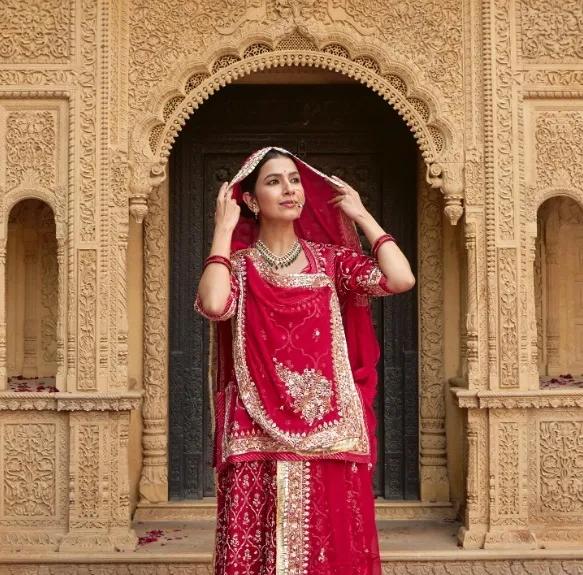May 30, 2024
Rajputi Poshak: The Majestic Attire of Rajasthani Royalty
Rajasthan, the land of kings, is renowned for its rich cultural heritage, vibrant traditions, and exquisite craftsmanship. Among the many facets that showcase the opulence of Rajasthani culture, one of the most iconic elements is the Rajputi Poshak. These traditional outfits worn by Rajasthani women are not just garments; they are a symbol of pride, tradition, and elegance, embodying centuries of heritage and artistry.
Origins and History
The history of Rajputi Poshak can be traced back to the royal courts of Rajasthan, where it was worn by Rajput women as a mark of their aristocratic status. The term "Rajputi Poshak" itself reflects the connection to the Rajput community, known for its valor, chivalry, and a deep sense of honor.
The evolution of Rajputi Poshak is a testament to the artistic ingenuity of Rajasthani craftsmen. Initially, these outfits were simpler in design, primarily consisting of a ghagra (skirt), kanchli (blouse), and odhni (dupatta). Over time, influenced by Mughal and Persian styles, the Poshak underwent transformations, incorporating intricate embroidery, dazzling embellishments, and a diverse color palette.
Elements of Rajputi Poshak
Ghagra: The ghagra, or skirt, is a central piece of the Rajputi Poshak. It is typically long and voluminous, often adorned with elaborate embroidery, mirror work, and gota patti (gold and silver lace). The fabric used ranges from rich silks to fine cotton, depending on the occasion and personal preferences.
Kanchli: The kanchli, similar to a blouse or choli, complements the ghagra. It is tailored to fit snugly and is intricately embellished, sometimes with precious stones, zari work, or intricate thread work. The neckline and sleeves of the kanchli vary in style, reflecting regional variations and design preferences.
Odhni: The odhni, or dupatta, is a sheer piece of fabric that drapes over the head or shoulder, adding grace to the ensemble. Like the ghagra and kanchli, the odhni is adorned with exquisite embroidery, often depicting traditional motifs such as peacocks, flowers, or geometric patterns. It serves both a functional and decorative purpose, offering modesty and elegance.
Jewelry: No Rajputi Poshak is complete without traditional Rajasthani jewelry. This includes maang tikkas (forehead ornaments), rani haars (necklaces), bajubands (armlets), bangles, and earrings. The jewelry is crafted using precious metals like gold and silver and is often embellished with gemstones, enamel work, and intricate filigree.
Footwear: Rajasthani women pair their Rajputi Poshak with intricately designed footwear known as jootis or mojaris. These are handcrafted shoes made from leather or fabric, featuring embroidery, mirror work, and vibrant colors that complement the overall attire.
Regional Variations
Rajasthan is a diverse state, and different regions have their own unique styles and variations of Rajputi Poshak.
Jaipuri Style: The Rajputi Poshak from Jaipur is characterized by vibrant colors, intricate gota patti work, and elaborate embroidery. The use of bold motifs and contrasting hues makes Jaipuri Poshak stand out.
Mewari Style: In Udaipur and the Mewar region, Rajputi Poshak is known for its regal elegance. The outfits are often adorned with intricate silver or gold zari work, reflecting the royal heritage of the area.
Marwari Style: Marwari Poshak is renowned for its mirror work, vibrant bandhej (tie-dye) patterns, and traditional motifs like elephants, peacocks, and flowers. The colors used are typically bright and cheerful, symbolizing the festive spirit of the region.
Jodhpuri Style: Jodhpur is famous for its royal blue hues and intricate embroidery. The Rajputi Poshak from this region often features a fusion of traditional Rajasthani designs with modern elements, making it a favorite among contemporary fashion enthusiasts.
Occasions and Significance
Rajputi Poshak holds immense significance in Rajasthani culture and is worn on various occasions, each demanding its unique style and elegance:
Weddings: Rajputi Poshak is an integral part of Rajasthani weddings, symbolizing the grandeur and heritage of the occasion. The bride's attire is especially elaborate, with heavily embellished ghagras, kanchlis, and odhnis, paired with exquisite jewelry.
Festivals: During festivals like Diwali, Holi, and Teej, women adorn themselves in vibrant Rajputi Poshak, celebrating the colors and traditions of Rajasthan with dance, music, and cultural festivities.
Cultural Events: Rajputi Poshak is showcased in cultural events, fashion shows, and exhibitions, highlighting the craftsmanship and artistic finesse of Rajasthani artisans.
Social Gatherings: Women often wear Rajputi Poshak for social gatherings, family functions, and religious ceremonies, showcasing their pride in tradition and heritage.
Contemporary Influence and Global Appeal
While Rajputi Poshak remains deeply rooted in tradition, it has also evolved to embrace contemporary trends and styles. Designers and fashion houses have reinterpreted this classic attire, infusing it with modern cuts, fabrics, and embellishments, making it accessible to a global audience.
The allure of Rajputi Poshak has transcended cultural boundaries, with celebrities, dignitaries, and fashion enthusiasts worldwide embracing its elegance and charm. Its popularity has also surged due to destination weddings in Rajasthan, where brides from diverse backgrounds choose Rajputi Poshak for its timeless appeal and cultural significance.
Preserving Heritage and Artistry
Despite modern influences, there is a concerted effort to preserve the authenticity and craftsmanship associated with Rajputi Poshak. Artisans, weaving communities, and government initiatives work together to promote traditional techniques, provide livelihood opportunities, and ensure the sustainability of this rich heritage.
Conclusion
In conclusion, Rajputi Poshak embodies the soul of Rajasthan, encapsulating centuries of heritage, craftsmanship, and cultural vibrancy. From the regal courts of the past to the global runways of today, it continues to enchant and inspire, symbolizing the timeless elegance and pride of Rajasthani women.
For more info:- leheriya sarees
